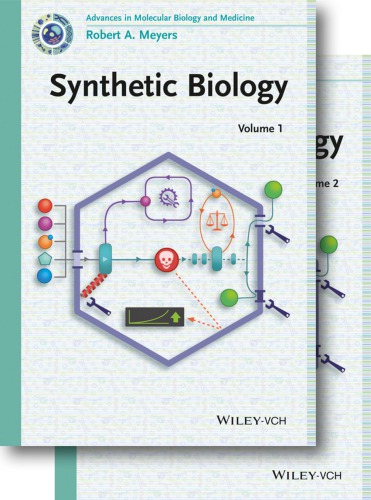

Most ebook files are in PDF format, so you can easily read them using various software such as Foxit Reader or directly on the Google Chrome browser.
Some ebook files are released by publishers in other formats such as .awz, .mobi, .epub, .fb2, etc. You may need to install specific software to read these formats on mobile/PC, such as Calibre.
Please read the tutorial at this link. https://ebooknice.com/page/post?id=faq
We offer FREE conversion to the popular formats you request; however, this may take some time. Therefore, right after payment, please email us, and we will try to provide the service as quickly as possible.
For some exceptional file formats or broken links (if any), please refrain from opening any disputes. Instead, email us first, and we will try to assist within a maximum of 6 hours.
EbookNice Team

Status:
Available4.8
23 reviews2.2 Surface Chemistry2.3 The Origin of Nucleotides and the RNA-Metabolism World; 2.4 From Substrates to Templates: the RNA-Genome World; 3 Origin of Extant Cells; 3.1 Origin of the Archaea; 3.2 Origin of the Bacteria; 3.3 From Protokarya to Eukarya; 3.4 Between Domains: the Perpetuation of Horizontal Gene Transfer; 4 Conclusion; References; Chapter 3 Regulation of Gene Expression; 1 Introduction; 2 Regulation of Gene Expression in Prokaryotes; 2.1 Induction and Repression; 2.2 The Operon; 2.2.1 The Lactose Operon (lac Operon); 2.2.2 The Histidine Operon; 2.2.3 The Tryptophan Operon.
2.2.4 The Arabinose Operon (ara Operon)2.3 Positive and Negative Control; 2.4 Attenuation: The Leader Sequence; 2.5 Catabolite Repression; 2.6 Cyclic AMP Receptor Protein; 2.7 Guanosine-5'-Diphosphate,3'-Diphosphate; 2.8 Riboswitch; 2.9 Regulon; 3 Regulation of Gene Expression in Eukaryotes; 3.1 Transcriptionally Active Chromatin; 3.2 Regulation of Gene Expression at the Initiation of Transcription; 3.3 Regulation of Gene Expression in Chloroplasts; 3.4 Regulation of Gene Expression in Mitochondria; 4 RNA Splicing; 4.1 Nuclear Splicing; 4.2 Splicing Pathways; 4.2.1 Spliceosomal Introns.
4.2.2 Spliceosome Formation and Activity4.2.3 Self-Splicing; 4.2.4 tRNA Splicing; 4.3 cis- and trans-Splicing Reactions; 4.4 Alternate Splicing; 5 Role of microRNAs (miRNAs) in the Regulation of Gene Expression; 6 Chromatin Structure and the Control of Gene Expression; 7 Epigenetic Control of Gene Expression; 8 Gene Regulation by Hormonal Action; 9 Post-Transcriptional Regulation of mRNA; 10 Transport of Processed mRNA to the Cytoplasm; 11 Regulation of Gene Expression at the Level of Translation; Acknowledgments; References; Chapter 4 Interactome; 1 Introduction.
2 Experimental Techniques for Detecting Protein Interactions3 Computational Prediction of Protein Interactions; 3.1 Interaction Prediction from the Gene Patterns Across Genomes; 3.1.1 Gene Fusion; 3.1.2 Gene Order; 3.1.3 Phylogenetic Profiling; 3.2 Predicting Interaction from Sequence Coevolution; 3.3 Domain Interactions; 3.4 Coexpression Networks; 4 Exploring the Topology of the Interactome; 4.1 Global Properties; 4.2 Network Centrality and Protein Essentiality; 4.3 Network Modules; 4.4 Network Motifs and Related Concepts; 5 Comparing Protein-Protein Interaction Networks.
6 Databases of Protein and Domain Interactions.
These two volumes contain a selection of updated articles from the acclaimed Meyers Encyclopedia of Molecular Cell Biology and Molecular Medicine, the most authoritative resource in cell and molecular biology, combined with new articles by ""founding fathers"" in the field. The work is divided into six sections: + Biological Basis + Modeling + Modular Parts and Circuits + Synthetic Genomes + Diseases and Therapeutics + Chemicals Production. Ideally suited as advanced reading for students and postdocs, and with all current research trends covered by an impressive number of leading figur.
2.2 Surface Chemistry2.3 The Origin of Nucleotides and the RNA-Metabolism World; 2.4 From Substrates to Templates: the RNA-Genome World; 3 Origin of Extant Cells; 3.1 Origin of the Archaea; 3.2 Origin of the Bacteria; 3.3 From Protokarya to Eukarya; 3.4 Between Domains: the Perpetuation of Horizontal Gene Transfer; 4 Conclusion; References; Chapter 3 Regulation of Gene Expression; 1 Introduction; 2 Regulation of Gene Expression in Prokaryotes; 2.1 Induction and Repression; 2.2 The Operon; 2.2.1 The Lactose Operon (lac Operon); 2.2.2 The Histidine Operon; 2.2.3 The Tryptophan Operon.
2.2.4 The Arabinose Operon (ara Operon)2.3 Positive and Negative Control; 2.4 Attenuation: The Leader Sequence; 2.5 Catabolite Repression; 2.6 Cyclic AMP Receptor Protein; 2.7 Guanosine-5'-Diphosphate,3'-Diphosphate; 2.8 Riboswitch; 2.9 Regulon; 3 Regulation of Gene Expression in Eukaryotes; 3.1 Transcriptionally Active Chromatin; 3.2 Regulation of Gene Expression at the Initiation of Transcription; 3.3 Regulation of Gene Expression in Chloroplasts; 3.4 Regulation of Gene Expression in Mitochondria; 4 RNA Splicing; 4.1 Nuclear Splicing; 4.2 Splicing Pathways; 4.2.1 Spliceosomal Introns.
4.2.2 Spliceosome Formation and Activity4.2.3 Self-Splicing; 4.2.4 tRNA Splicing; 4.3 cis- and trans-Splicing Reactions; 4.4 Alternate Splicing; 5 Role of microRNAs (miRNAs) in the Regulation of Gene Expression; 6 Chromatin Structure and the Control of Gene Expression; 7 Epigenetic Control of Gene Expression; 8 Gene Regulation by Hormonal Action; 9 Post-Transcriptional Regulation of mRNA; 10 Transport of Processed mRNA to the Cytoplasm; 11 Regulation of Gene Expression at the Level of Translation; Acknowledgments; References; Chapter 4 Interactome; 1 Introduction.
2 Experimental Techniques for Detecting Protein Interactions3 Computational Prediction of Protein Interactions; 3.1 Interaction Prediction from the Gene Patterns Across Genomes; 3.1.1 Gene Fusion; 3.1.2 Gene Order; 3.1.3 Phylogenetic Profiling; 3.2 Predicting Interaction from Sequence Coevolution; 3.3 Domain Interactions; 3.4 Coexpression Networks; 4 Exploring the Topology of the Interactome; 4.1 Global Properties; 4.2 Network Centrality and Protein Essentiality; 4.3 Network Modules; 4.4 Network Motifs and Related Concepts; 5 Comparing Protein-Protein Interaction Networks.
6 Databases of Protein and Domain Interactions.
These two volumes contain a selection of updated articles from the acclaimed Meyers Encyclopedia of Molecular Cell Biology and Molecular Medicine, the most authoritative resource in cell and molecular biology, combined with new articles by ""founding fathers"" in the field. The work is divided into six sections: + Biological Basis + Modeling + Modular Parts and Circuits + Synthetic Genomes + Diseases and Therapeutics + Chemicals Production. Ideally suited as advanced reading for students and postdocs, and with all current research trends covered by an impressive number of leading figur